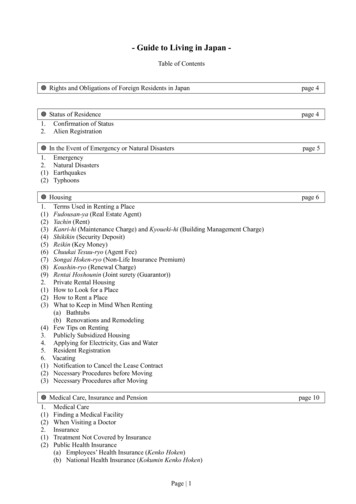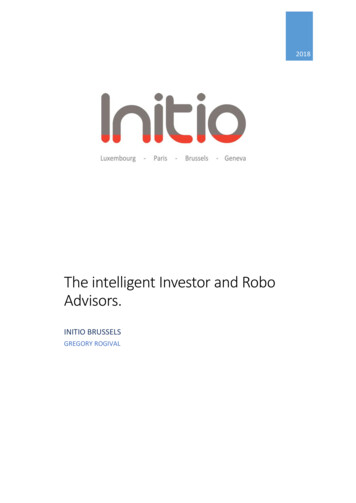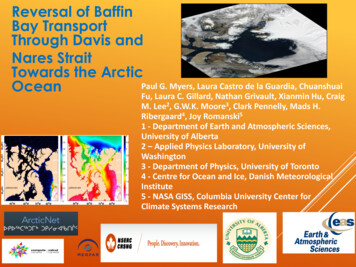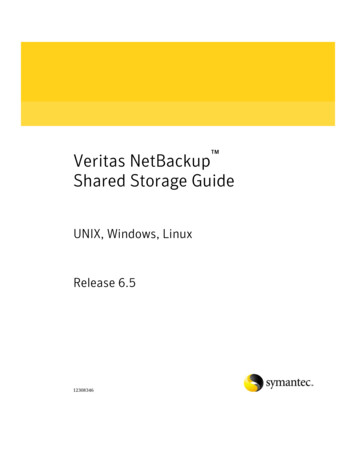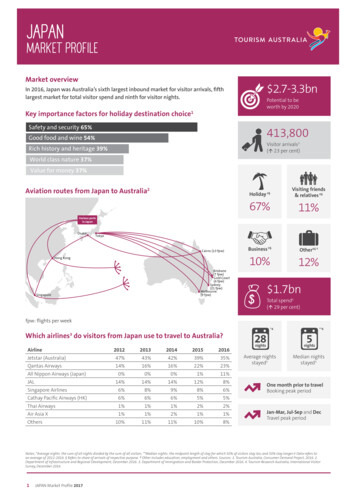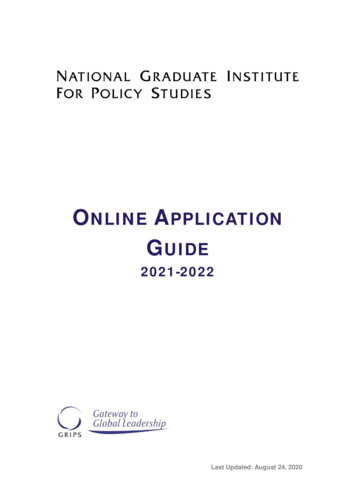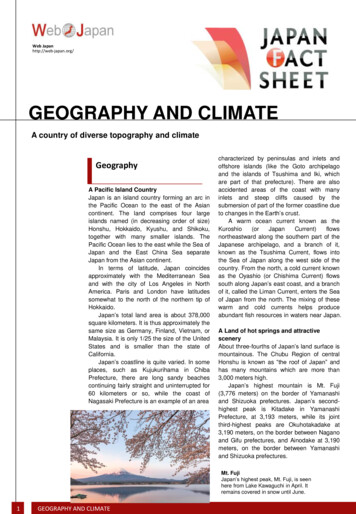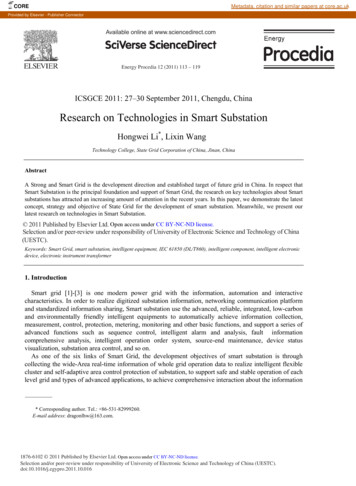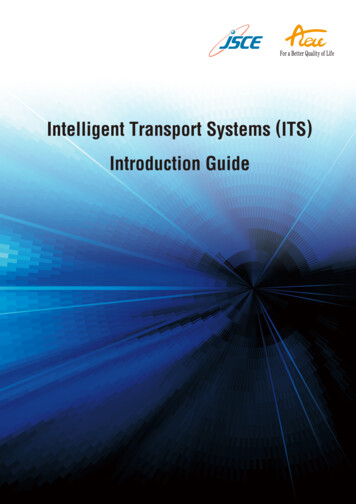
Transcription
Intelligent Transport Systems (ITS)Introduction Guide
Intelligent Transport Systems (ITS)Introduction Guide
PREFACELately, a number of countries in Asia Pacific Region have been developing road infrastructure rapidly.Meanwhile, rapid economic growth and population concentration in urban areas have caused urban trafficproblems such as congestion, accidents, and environmental problems that became serious in developingcountries as well as in developed countries. In such circumstances, several countries are making attemptto resolve such traffic problems using Intelligent Transport Systems (ITS), some of them showingsignificant improvement. In order to introduce and advance ITS in countries, it is critical to share commonperceptions of knowledge/expertise in the following aspects: 1) how to employ ITS effectively in order toresolve urban traffic issues, 2) how to integrate information technologies and transport infrastructure, and3) how to build a platform for ITS to perform properly.Given such environment, Asian Civil Engineering Coordinating Council (ACECC) approved theestablishment of the Technical Committee for the theme of “ITS-based Solutions for Urban TrafficProblems in Asia Pacific Countries (TC-16),” proposed by the Japan Society of Civil Engineers (JSCE) atthe Technical Committee Coordination Meeting in Tokyo, on March 1, 2012.The TC-16 consists of ten members from eight countries: Japan, Korea, Thailand, Taiwan, Australia,Malaysia, the Philippines, and the United States. Since its establishment, we have collected examples ofITS-based solutions using state-of-the-art Information and Communication Technologies (ICT) foraforementioned common issues in Asian countries, and encouraged discussion on approaches of ITSintroduction according to country’s level of economic growth and national land development.In this Guide, we described ITS-based solutions for urban traffic problems and low-cost ITS introductionprocesses in detail, based on discussions in the TC-16 activities. In addition, examples of ITS introductionand its various applications in different countries are presented for reference.Lastly, we strongly wish that civil and road engineers in Asian countries take advantage of this “ITS Guide”and the Guide will contribute to resolving transport issues. This publication is supported by InternationalScientific Exchange Fund (ISEF) of JSCE. And we would like to take this opportunity to express oursincere gratitude for those supported and advised in the course of development of the Guide.Chief EditorAugust, 2016Hiroshi MAKINO
ACECC TC16 TC MEMBERSChairHiroshi MAKINO (ITS Division, NILIM, MLIT, JAPAN)Co-ChairShunsuke KAMIJO (Institute of Industrial Science, University of Tokyo, JAPAN)Chi-Hyun Shin (Kyonggi University, Korea)MemberSorawit Narupiti (Chulalongkorn University., Thailand)Jason Chang (National Taiwan University., Taiwan)Edward Chung (Queensland University. of Technology, Australia)Ahmad Farhan Mohd Sadullah (University. Sains Malaysia, Malaysia)Ching-Yao Chan (University of California at Berkeley, USA)Ricardo G.Sigua (University of the Philippines, the Philippines)SecretaryKazuya TAMADA (ITS Division, NILIM, MLIT, JAPAN)MLIT: Ministry of Land, Infrastructure and TransportNILIM: National Institute for Land and Infrastructure ManagementIntelligent Transport Systems (ITS)Introduction GuideEditorsHiroshi MAKINO (ITS Division, NILIM, MLIT, JAPAN)Shunsuke KAMIJO (Institute of Industrial Science, University of Tokyo, JAPAN)Chi-Hyun Shin (Kyonggi University, Korea)Edward Chung (Queensland University. of Technology, Australia)AssistantsTakahiro TSUKIJI (National Highway and Risk Management Division, Road Bureau,MLIT, JAPAN)Kazuya TAMADA (ITS Division, NILIM, MLIT, JAPAN)Tomoaki MIZUTANI (ITS Division, NILIM, MLIT, JAPAN)Takumi NISHIMURA (Transport and Socioeconomic Research Division, IBS, JAPAN)Hiromi KASUYA (Transport and Socioeconomic Research Division, IBS, JAPAN)MLIT: Ministry of Land, Infrastructure and TransportNILIM: National Institute for Land and Infrastructure ManagementIBS: The Institute of Behavioral Sciences
Table of Contents1.2.3.4.5.6.Introduction . 1-11.1Introduction . 1-21.2Topic: What is ITS? . 1-3Issues in Road Traffic. 2-12.1Urbanization . 2-22.2Increase in transport demand, and CO2 emissions . 2-32.3Exacerbation of Traffic Safety . 2-62.4Exacerbation of Traffic Congestion. 2-7Components of ITS . 3-13.1Pattern of ITS Configuration . 3-23.2Vehicles (ITS Onboard Unit) . 3-33.3Communications . 3-73.4Positioning . 3-143.5Mapping . 3-193.6Sensing . 3-20Applications . 4-14.1Traffic Control. 4-24.2Traffic Signal Control . 4-84.3Electronic Fee and Toll Collection (EFC) System . 4-144.4Probe car data collection . 4-274.5Road Management Using Probe Car Data. 4-324.6Information Provision Services on Roads . 4-374.7Bus Location . 4-434.8Public Transport Priority System (PTPS) . 4-45Introduction and Promotion of ITS . 5-15.1ITS Planning and Evaluation . 5-25.2Items to be studied at the time of ITS Introduction. 5-105.3Items to be studied to ensure the Smooth Promotion of ITS . 5-205.4Step-Up Approach to the Introduction of ITS . 5-265.5Training and Education . 5-28Appendix: Acronyms . 6-1
11.IntroductionIntroduction1-1
1Introduction1.1 IntroductionRoads are a core piece of infrastructure that supports the movement of people and logistics, forming thefoundation of social and economic development and interconnecting cities, ports, projects and airports.But while road maintenance and improvements bring about economic development, the increased volumeof traffic causes problems such as traffic accidents and congestion. In recent years the growth ofpopulation, progress of urbanisation and rapidly increasing car ownership in Asian countries hasexacerbatedthe negative effects caused by cars, resulting in a massive increase of traffic accidents,congestion and environmental deterioration due to emission gas.The Intelligent Transport Systems (ITS) is a new road and traffic system which combines information,communication, and control technologies to properly integrate drivers, vehicles and roads in a way thatsupports people driving. Its aim is to solve not only car traffic issues but also socioeconomic issues, whichinclude ageing, a declining CBD, tourism vitalization, and sustainable economic development utilizinginformation communication technology.This document will explain the elements of ITS, provide concrete applications to solve the issues and listmeasures to efficiently and effectively implement it as a working system in Asian countries. ITS placesvehicles at the centre of the system as a moving object, rather than building a system in a factory or office.It uses sensing, positioning, mapping, communication and networks to solve issues by integrating themand then connecting people, vehicles and roads.The ITS applications aim to solve the issues at three main levels: society, the road administrator anddrivers. At a societal level, the applications would decrease accidents by way of safe driving support, aswell as reduce traffic congestion by providing ongoing congestion information, in lowering theenvironmental impact. For the road administrator, hazardous locations and frequently congested areascould be easily identified by probe information collected from vehicles; this would enable the roads to bemanaged more efficiently and at a lower cost.Drivers would enjoy economic advantages such asreduced tolls, use of the route information and benefits such as nonstop toll payment and parking feepayment.Some countries have attempted to implement ITS and experienced positive results. However, they havestill come up against various issues which have inhibited its success, such as systems not being properlyintegrated, not having enough expertise, not establishing a master plan,or, importantly, financialrestrictions.In order to effectively introduce an ITS, it is important to select information communication technology andapplications tailored to each country and region. , This includes drawing up and efficiently promoting anappropriate introduction plan and project scheme, building consensus among related parties, andensuring an adequate budget and system is in place.We hope that this document would provide workable suggestions in solving common car traffic issuesexperienced around the world.1-2
1Introduction1.2 Topic: What is ITS?Intelligent Transport Systems, or ITS, is a new transportation system which aims to resolve a variety ofroad traffic issues, such as traffic accidents and congestion, by linking people, roads, and vehicles in aninformation and communications network via cutting-edge technologies. It includes, for example, a roadtraffic information provision system in which road traffic information is collected via roadside sensors andthen provided to drivers.ITS provides people with a variety of convenient road traffic applications. In addition, the provision of newITS applications through the use of a variety of information and communications technologies greatlycontributes to the creation of new business opportunities and markets, as well as the vitalization ofeconomic activities.Figure 1.2-1 Components of ITSThe three most important components needed for establishing ITS are location, mapping, andcommunications.An example of the component technology used for location includes the Global Positioning System (GPS)and the Galileo system, a system that is being promoted in Europe. As GPS receivers have become quiteinexpensive, they are now extensively used on familiar information devices, such as car navigationsystems and mobile phones.Mapping is a technology that plots location information on a map and can be realized with the help of adigital map.1-3
1IntroductionCommunications can be realized via a variety of telecommunications and broadcasting technologies,such as FM multiplex broadcasting, mobile phones, and DSRC. This needs to be spelled out in full. Asthese communication media have varying characteristics, such as long-range or short-range, one-way ortwo-way, and free or fee-based, an optimal combination of communication media needs to be studied andselected according to the types of ITS applications.It is also important to establish a common platform using ITS as the base for these informationtechnologies for linking people, vehicles, and roads. To be more specific, in addition to establishingcommon communication infrastructures, common communication methods, and common data formats,among other things, it is important to establish onboard unit, roadside units and the systems, among otherthings, that are compatible with all available applications.It is expected that the establishment of a common platform will contribute to the improved scalability ofapplications and improved user convenience, such as securing the compatibility of single onboard unitwith multiple applications.1-4
22.Issues in Road TrafficIssues in Road Traffic2-1
2Issues in Road Traffic2.1 UrbanizationGlobally, population in urban areas increased at a far more rapid rate during the 20th century than those inrural areas. According to the United Nations, 30% of the world’s population lived in urban areas in 1950;today that figure stands at 54%. The UN expects that by 2050, 66% of the world’s entire population willlive in cities.Today, the world’s largest city is Tokyo; followed by Delhi, Shanghai, Mexico City, Mumbai, and Sao Paolo.It’s predicted that by 2050, urban populations in Asia and Africa in particular will have increasedexponentially.Assuming these predictions are correct and urbanization continues to increase, it is also fair to assumethat road traffic issues, such as congestion and its impact on the environment will only worsen.Figure 2.1-1 Urban and Rural Population of the World, 1950-2050(Source: UN, World Urbanization Prospects)2-2
2Issues in Road Traffic2.2 Increase in transport demand, and CO2 emissionsAccording to estimates by the International Transport Forum (ITF), road and rail passenger traffic willincrease by 120%–230% by 2050 worldwide (estimates vary depending onfuture oil prices and urbantransport policies). The increases are predicted to take place mainly in non-OECD countries wherepassenger traffic is expected to increase by 250%–450%. As a result, worldwide CO2 emissions fromsurface passenger transport are estimated to increase by 30%–110%.Figure 2.2-1 Passenger Transport in vehicle-kilometers, 2050 (2010 100)(Source: ITF, ITF Transport Outlook 2015)Figure 2.2-2 CO2 Emissions from Surface Passenger Transport, 2050 (2010 100)(Source: ITF, ITF Transport Outlook 2015)2-3
2Issues in Road TrafficWorldwide freight traffic by road and rail is estimated to increase by 230%–420% by 2050, increasingassociated CO2 emissions by 140%–350%. Again, the increase in CO2 emissions associated withworldwide surface freight traffic is expected to originate in non-OECD countries. By 2050, Asian countries,including China and India, are anticipated to account for over 50% of global surface freight traffic (35% atpresent).Figure 2.2-3 Surface Freight Transport in tonne-kilometers, 2050 (2010 100)(Source: ITF, ITF Transport Outlook 2015)Figure 2.2-4 CO2 Emissions from Surface Freight Transport, 2050 (2010 100)(Source: ITF, ITF Transport Outlook 2015)2-4
2Issues in Road TrafficAccording to the International Energy Agency (IEA), global CO2 emissions reached 32.2 billion tonnes in2013. Approximately 23% of CO2 emissions are derived from the transport sector, which includes air, ship,rail, and road traffic. Of the CO2 emissions caused by the transport sector, three quarters are of those arecaused by road traffic.Figure 2.2-5 World CO2 Emissions by sector in 2013(Source: IEA, CO2 Emissions from Fuel Combustion)Figure 2.2-6 CO2 Emissions from Transport(Source: IEA, CO2 Emissions from Fuel Combustion)2-5
2Issues in Road Traffic2.3 Exacerbation of Traffic SafetyApproximately 1.3 million people have lost their lives in traffic accidents globally. A further 20 to 50 millionpeople have been injured. Traffic accidents are the primary cause of death for young generationsworldwide. A vast majority of these fatal accidents and injuries happen in developing countries whereawareness and provision for traffic safety are relatively low. In addition, almost half of the victims arevulnerable road users such as pedestrians, bicycle users and motorcyclists. Along with the grief causedby traffic accidents, they cause immense economic losses corresponding to about 1%–3% of GNP.Deaths (million)MalariaTuberculosisHIV/AIDSRoad Traffic InjuriesFigure 2.3-1 Projections of Global Mortality (All Ages) to 2030(Source: WHO, Global Burden of Disease 2008)2-6
2Issues in Road Traffic2.4 Exacerbation of Traffic CongestionThe European Union (EU) predicted in its White Paper on Transport (2011) that economic losses causedby traffic congestion will increase by 50% in EU nations by 2050.The situation is far more serious in Asianmegacities. The World Bank estimated in 2014 that the economic costs of delayed deliveries caused bytraffic congestions in Kuala Lumpur alone corresponded to up to 1.8% of Malaysian GDP.【Jakarta, Indonesia】【Delhi, India】【Dhaka, Bangladesh】【Ulaanbaatar, Mongol】Figure 2.4-1 Traffic Congestions in Asian Cities(Source: Meeting Document for Council on Infrastructural Development)2-7
2Issues in Road Traffic2-8
3 Components of ITS3.Components of ITS3-1
3 Components of ITS3.1 Pattern of ITS ConfigurationThe patterns of ITS configuration may include (i) two-way communication (active system), (ii) one-waycommunication (passive system), and (iii) telematics systems, among other things.Figure 3.1-1 Components of ITSThe chief characteristic of the active system (i) is that it is readily deployable to a wide variety ofapplications via interactive communication.On the other hand, the chief characteristic of the passive system (ii) is that the installation of onboard unitis simple and low cost.The telematics system (iii), which was adopted in Europe for the charging of tolls to trucks, among otherthings, is advantageous in charging fees for a wider geographic area as it does not require the installationof roadside infrastructures.In many of the countries where there are a large number of relatively low-income road users, a systemthat allows the use of low cost onboard unit has been adopted. However, there have disadvantages thatleave a heavier burden on backyard systems, incurring substantial costs and forcing a road user topurchase new onboard unit when a new application is added. It is recommended that, when studying theadoption of the pattern of ITS configuration, its future scalability be taken into account.3-2
3 Components of ITS3.2 Vehicles (ITS Onboard Unit)3.2.1 Essential Functions of Onboard UnitOnboard unit (OBU), which is mounted on a vehicle, is expected to play the following roles in ITS:communicate with roadside infrastructures, transfer necessary information, process the payment of tolls,and act as an interface (as a bridge) between road infrastructures and a driver, amongst other things.To be more specific, the essential functions of onboard unit are summarized as follows:Table 3.2-1 Functions of Required for ITS OBUFunctionExplanationInstructionThe function which returns user’s response to the command receivedresponse functionby ITS OBU to roadside system using the button of ITS OBUMemory accessThe function which loads or writes data stored in memory of ITS OBUfunctionaccording to the command from roadside systemIC card accessThe function which sends or receives payment information accordingfunctionto the command from roadside systemThe function which executes transaction automatically according toPush-typeinformationdelivery functionthe type of contents from roadside systemThere are two types of method: one is the method which deliverscontents themselves (contents push type) and the other is themethod which delivers the location to contents (URL, etc.) andacquires the content by HTTP or something (pseudo push type).Common securityfunctionThe function which certifies equipment by cross certification betweenITS OBU and roadside system and is compatible for encryptedcommunication using the key exchanged through cross certification3-3
3 Components of ITS3.2.2 Concept to Ensure Future ScalabilityWhen implementing ITS applications, it is important to take into account ITS compatibility with possiblefuture applications. If it is necessary to install new onboard unit in a vehicle or to make modifications to theexisting onboard unit, when a new application is added, roadside units must check whether relevantapplications are installed in onboard unit, etc., thus making procedures for implementing applicationsmore complicated and causing a problem in managing the sound implementation of applications. Inaddition, the replacement of onboard unit and addition of applications to onboard unit results in causingundue burden to users, etc., in terms of time and cost.EFCFigure 3.2-1 Concept to Ensure Future Scalability3-4
3 Components of ITS[Reference] ITS Onboard Unit in JapanIn Japan, it has been agreed through discussions with automotive manufacturers that ITS onboard unitis initially equipped with several common basic functions that are considered to be required oncemultiple applications become available. Specifically, such common basic functions includecommand/response function, memory access function, an IC card access function, a push-typeinformation delivery function, onboard unit ID communication function, and onboard unit’s basiccommand function. An overview of each of these functions is outlined as follows:In addition, by developing and installing roadside systems that are capable of utilizing these basicfunctions of ITS onboard unit, it is possible to implement such new applications without new onboardunit or modifications to the existing onboard unit.As a specific example of an ITS onboard unit that meets the above criteria, ITS onboard unit that hasbeen put to practical use and has been widely used in Japan is shown below.In Japan, ITS onboard unit with a large liquid crystal display (LCD) screen and speakers which GNSSand DSRC unit capable of processing payments by credit cards are combined is put to practical use andsold on the market. Figure 3.2-2 An example of ITS OBU in Japan (From Panasonic Corporation HP)ITS onboard unit incorporates some notable functions, some new, such as Internet connections,processing payments by credit card, voice commands, push-type information delivery and probe. This isin addition to the enhancement of IVI’ existing function so as to provide traffic congestion informationover a wider geographical area due to the increased communication capacity. It is now possible todevelop a variety of applications for use when a vehicle is in operation, parked, or stopped, bycombining these basic functions. (See Figure 3.2-2 )3-5
3 Components of ITSTable 3.2-2 Common basic function of ITS OBU (Basic API, Basic security function)EFCCar navigationsystem (IVI)Expressway toll payment (Killer application)Navigation (Killer application)New IVIBroader and easier to understandAHSSafe driving information provision (World first)Probe car dataIVI / enhancement of safe application is enabledInternetOn-demand application (Sightseeing information, update of mapCredit card paymentCashless payment, establishment of business modelVoice guidanceEasy roadside broadcast, sightseeing guideA car navigation system will most likely evolve as a device that primarily operates as the brain of avehicle, in conjunction with the vehicle information held by a vehicle and the operation of a vehicle.Importantly, a car navigation system will most likely evolve by incorporating communication functionswhere it is weak; based on applications that enable it to operate in conjunction with EFC, whichprocesses the payment of tolls while a vehicle is in operation, AHS, which provides information on safedriving, and electric vehicle (EV) charging information.It is also expected that smartphones will create a new market for car navigation systems for casualusers/drivers who are not interested in purchasing a car navigation system.That said, it is necessary to fully study the development of human-machine interfaces (HMI) assumingthat a car navigation system is used when a vehicle is in operation. We advise aiming to link carnavigation system to functions, such as EFC and AHS, after the development of HMI.The important thing is that, as in the case of cloud applications which have been popular in the mediarecently, information is seamlessly transferred and shared regardless of what devices are being used.For example, your trip by vehicle will likely go like this: you research your destination at home prior toyour trip, determine a travel route, tourist attractions to visit and where to stay. All this information istransferred to a car navigation system. The car navigation system then guides you to your destinationsmoothly and safely, avoiding traffic congestion along the way by utilizing IVI and EFC. At yourdestination, you get information on tourist attractions and other helpful tips via a smartphone so that youcan enjoy sightseeing.In other words, differences in communication standards and communication devices do not mattermuch. The important thing is that the contents and applications that users need are seamlesslyprovided.3-6
3 Components of ITS3.3 Communications3.3.1 Comparison of Radio Communication TechnologiesThere are a variety of means of communication that connect roads (roadside systems) with vehicles (ITSonboard unit), such as mobile phones, DSRC and FM multiplex broadcasting. As each of these means ofcommunication has its own unique characteristics, it is advisable to use the radio communicationtechnology that best suits the characteristics of applications.That said, it is uneconomical in terms of costs to install a device that is compatible with the relevantcommunications standards for each application. Therefore, when establishing ITS, it is important to selectthe optimal means of communications by taking into account the required specifications of applicationsand other relevant matters.Technologies that connect roads and vehicles are roughly divided into communications technologies andbroadcasting technologies.The comparison of communications and broadcasting technologies is shown as follows:Table 3.3-1 Difference between “communications” and “broadcasting” technologyCommunicationBroadcastingInformation provided areaRelatively small range(dependent on method)Relatively wide range(dependent on method)One way / Two wayTwo way(One way in some cases)One waySuitable application type- Information provisionaccording to individual user- Applications which requiretwo way communication- Wide range and concurrentinformation provisionIn the case of ITS communications, it is necessary to study communication technologies in terms ofcapacity levels, areas covered, response time and reliability (requirements for communication reliabilityare more stringent, especially in the case of applications related to safe driving assist and the processingof toll payments). Specifically, as requirements for communication technologies are more demanding inthe case of remote road-to-vehicle communications, such as those related to safe driving assist underhigh speed operation, and vehicle-to-vehicle communications, it is important to adopt highly reliablecommunication technologies with short response time (such as DSRC). (See Figure 3.3-1)3-7
3 Components of ITSAccident prevention inmerging sectionReal time traffic informationCurve accident preventionin intersectionInformation provision onaccident or stopped vehicleCollision preventionCellular phone or wireless LANHourMinuteLowITS FORUM RC-006, WAVE, etc.DSRC or optical beacon10 sec.1 sec.Crossing accidentprevention100 msReliability of communication20 msHighFigure 3.3-1 Relation between response time / reliability of communication and ITS applicationsTable 3.3-2 Characteristics and use of wireless communication technologyCapa-technologycity*BroadcastingWireless communicationStabilityCommunicationUse in ITSexpenses- Car navigation systemDigitalWidebroadcastrangeFMLargeSlow LargeSlow geWIMAXLargeSlowLTELargeSlow LargeSlow MiddleFast ca- Request type applications- Probe car data collection- Membership application- Not for EFC because of poorspeed.- Internet during stop- EFC and safety applications- V2V, V2I- Used for internet during stop- Inf
Introduction Guide Editors Hiroshi MAKINO (ITS Division, NILIM, MLIT, JAPAN) Shunsuke KAMIJO (Institute of Industrial Science, University of Tokyo, JAPAN) Chi-Hyun Shin (Kyonggi University, Korea) Edward Chung (Queensland University. of Technology, Australia) Assistants Takahiro TSUKIJI (Na

